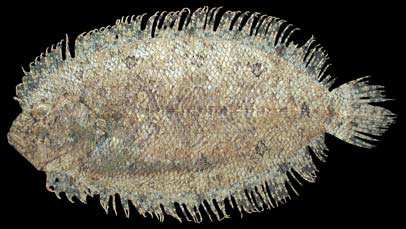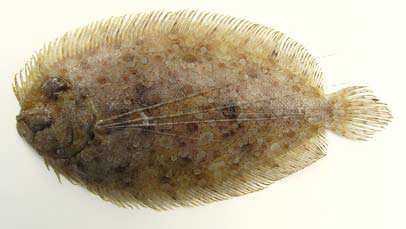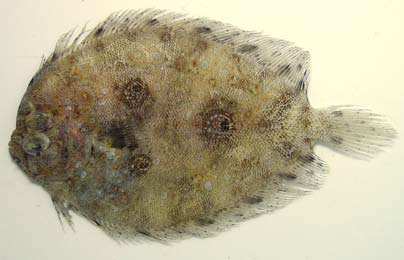BOTHIDAE
Lefteye Flounders
By Seishi Kimura
 Asterorhombus intermedius |
 Bothus pantherinus |
 Grammatobothus polyophthalmus |
|
Small to medium sized marine flatfishes; maximum size less than 88 cm. Body deep or somewhat elongated, strongly compressed. Both eyes on right side of head. Mouth small to large, superior, reaching to almost anterior margin of lower eye to well beyond posterior margin of lower eye. Preopercular margin visible, not covered with skin and scales. Dorsalfin origin just above or anterior to anterior margin of upper eye; all fins without spines; caudal fin apart from dorsal and anal fins; pectoral fins present on both sides of body, that of eyed side longer than that of eyeless side; pelvic fins present with 6-7 soft rays; pelvic fin of eyed side on midventral line and its origin anterior to pelvicfin origin of eyeless side; pelvic fin of eyeless side above midventral line. Lateral line on eyed side with high arch over pectoral fin; lateral line absent below lower eye. Color: body on eyed side brownish, usually with spots, blotches, or rings; eyeless side of body whitish, but dark colored in males of some species. Similar families occurring in the area. Bothidae is distinguished from other Indo-Pacific flatfish families in having eyes on left side of head, no fin spines, dorsal and anal fins not connecting with caudal fin, asymmetrical pelvic-fin bases, and no lateral line below lower eye. Psettodidae: dorsal-fin origin posterior to posterior margin of upper eye; anterior rays of dorsal and anal fins spinous; lateral line without high arch over pectoral fin. Cithalidae: pelvic fins with I spine, its bases nearly symmetrical. Paralichthyidae: pelvic-fin bases symmetrical. Samaridae and Pleuronectidae: eyes in most species on right side of body. Remarks. Usually found on sandy or muddy bottoms, but some species on rocky or coral reefs. Feeds on small fishes, crustaceans, and other benthic animals. Twenty genera. Food fish. |

|
|